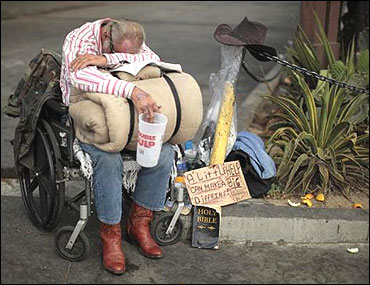 The number of Americans living in poverty has jumped by nearly three million to 49.1 million, or 16 per cent of the total population, according to latest census figures.
The number of Americans living in poverty has jumped by nearly three million to 49.1 million, or 16 per cent of the total population, according to latest census figures.
According to statistics released by the Census Bureau, 49.1 million Americans lived in poverty in 2010, which is higher than the 46.2 million found to live in poverty by the official measure released in September.
The addition of nearly three million people in the category of poor came under a new, comprehensive poverty measure that painted a more dismal picture of America's economic landscape than the official measure from September, the Washington Post reported.
The revised "supplemental poverty measure" for 2010 gives more weight to expenses such as taxes, child care, child support and out-of-pocket medical expenses.
The increased level of poverty was fueled by the sharply higher levels of poverty among senior citizens found by the alternative measure.
The poverty rate for those 65 and older was 15.9 per cent based on the supplemental measure, much higher than the nine per cent rate for the elderly when using the official poverty yardstick.
The biggest factor increasing the poverty rate for seniors under the alternative measure was out-of-pocket medical expenses, which are not captured by the official poverty rate but are by the alternative measure.
Among whites, 14.3 per cent were found to be in poverty under the supplemental measure, more than a percentage point higher than the 13.1 per cent poverty rate found by the official measure.
Hispanics had a poverty rate of 28.2 per cent under the alternative measure, higher than the official poverty rate of 26.7 per cent.
The proportion of black Americans living in poverty declined slightly under the alternative measure, from 27.5 per cent under the traditional measure to 25.4 per cent.
Although there are shortcomings, poverty experts say the supplemental measure offers a more comprehensive view of the nation's poverty picture than the official measure.
Meanwhile, according to a new report, the number of people living in neighbourhoods of extreme poverty grew by a third over the past decade, erasing most of the gains from the 1990s when concentrated poverty declined.
More than 10 per cent of America's poor now live in such neighbourhoods, up from 9.1 per cent in the beginning of the decade, an addition of more than two million people, the report by the Brookings Institution, an independent research group said.









 © 2025
© 2025